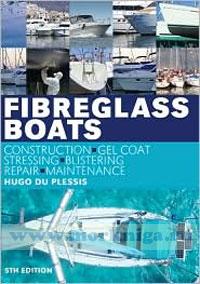Сб с 10 до 16
Fibreglass boats. Construction, gel coat stressing, blistering repair, maitnance. 5th edition
Introduction
Like the previous edition of Fibreglass Boats this is a technical book for non-technical readers, written in language the average boat owner or boatyard worker can understand. No knowledge of chemistry is needed, there are no baffling chemical equations and any mathematics is kept simple. More technical material is enclosed in boxes for interest, but it is not necessary for understanding the basic principles and may be ignored.
The book covers the materials and general principles of moulding, but mainly focuses on turning a floppy, bare fibreglass shell, straight out of the mould, into a strong, sound and seaworthy boat. That must always be the ultimate aim, a boat, whether you are doing it yourself or wondering whether somebody else did it right in the first place.
Содержание
Introduction
Section A General principles
1 Principlesf fibreglass boatbuilding
2 Materials
3 Tools and working conditions
4 Health and safety
Section В Understanding how fibreglass can fail
5 Physical failure
6 Destructive influences
7 Fatigue
8 Factorsf safety
9 Effectsf heat
10 Fire
Section С Turning a bare moulding into a boat
11 Glassing-in
12 Joins
13 Stiffening
14 Bulkheads
15 Attaching fittings
16 Sealants
17 Hardspots and stress concentrations
18 Double shell mouldings
19 Sandwichr cored mouldings
20 Wood and fibreglass
21 Fibreglass andther materials
22 Access
23 Weathering
Section D The gel coat - that shiny fibreglass look
24 Gel coat
25 Nasty little lumps
26 Can the gel coat be saved?
27 Replacing a gel coat
Section E In the beginning -moulding
28 Conditions for moulding
29 Moulding
30 Moulding faults
31 Mouldless construction
32 Thickness
33 Mechanisation
34 Inspection and quality
Section F Maintenance and use
35 Design for low maintenance
36 Maintenance and cleaning
37verloading
38 Painting
Section G Repair
39 Temporary repair
40 Minor repair
41 Major repair
42 Every crack tells a story
43 Testing
44 Disposal
Index

 Герои русского парусного флота
Герои русского парусного флота  В поисках Индии
В поисках Индии  Теория аэродинамики паруса. Ветродвижение. 2
Теория аэродинамики паруса. Ветродвижение. 2